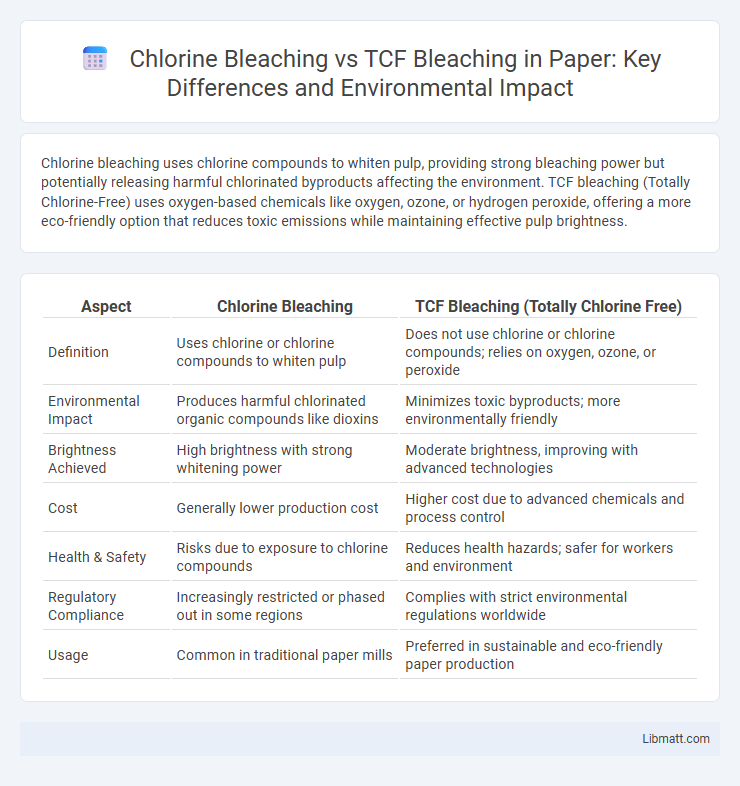Chlorine bleaching uses chlorine compounds to whiten pulp, providing strong bleaching power but potentially releasing harmful chlorinated byproducts affecting the environment. TCF bleaching (Totally Chlorine-Free) uses oxygen-based chemicals like oxygen, ozone, or hydrogen peroxide, offering a more eco-friendly option that reduces toxic emissions while maintaining effective pulp brightness.
Table of Comparison
| Aspect | Chlorine Bleaching | TCF Bleaching (Totally Chlorine Free) |
|---|---|---|
| Definition | Uses chlorine or chlorine compounds to whiten pulp | Does not use chlorine or chlorine compounds; relies on oxygen, ozone, or peroxide |
| Environmental Impact | Produces harmful chlorinated organic compounds like dioxins | Minimizes toxic byproducts; more environmentally friendly |
| Brightness Achieved | High brightness with strong whitening power | Moderate brightness, improving with advanced technologies |
| Cost | Generally lower production cost | Higher cost due to advanced chemicals and process control |
| Health & Safety | Risks due to exposure to chlorine compounds | Reduces health hazards; safer for workers and environment |
| Regulatory Compliance | Increasingly restricted or phased out in some regions | Complies with strict environmental regulations worldwide |
| Usage | Common in traditional paper mills | Preferred in sustainable and eco-friendly paper production |
Introduction to Pulp Bleaching Methods
Chlorine bleaching uses chlorine or chlorine compounds to remove lignin from pulp, producing bright paper but releasing harmful chlorinated organic compounds into the environment. Totally Chlorine Free (TCF) bleaching relies on oxygen-based agents like hydrogen peroxide and ozone, minimizing toxic effluents and promoting sustainable paper production. Choosing between these methods impacts the environmental footprint of Your paper products and aligns with evolving industry standards.
What is Chlorine Bleaching?
Chlorine bleaching involves using chlorine compounds such as chlorine gas or chlorine dioxide to whiten pulp by removing lignin from wood fibers, significantly enhancing paper brightness. This traditional method is highly effective but raises environmental concerns due to the release of toxic chlorinated organic compounds. Your choice between chlorine bleaching and Totally Chlorine Free (TCF) bleaching impacts both the environmental footprint and the quality of the resulting paper products.
Understanding TCF (Totally Chlorine-Free) Bleaching
Totally Chlorine-Free (TCF) bleaching eliminates all chlorine compounds during the pulp bleaching process, reducing the release of toxic chlorinated organic compounds into the environment compared to traditional chlorine bleaching. By utilizing oxygen-based chemicals such as ozone, hydrogen peroxide, and oxygen, TCF bleaching achieves high pulp brightness while minimizing ecological impact and improving water quality. This method supports sustainable forestry practices and aligns with stringent environmental regulations by significantly lowering the formation of dioxins and other persistent toxins.
Chemical Processes in Chlorine Bleaching
Chlorine bleaching involves the use of chlorine and chlorine compounds, such as chlorine dioxide and sodium hypochlorite, which react with lignin and other impurities in pulp to remove color and improve brightness. These chemical processes generate chlorinated organic compounds, including adsorbable organic halogens (AOX), which pose environmental risks and require careful effluent treatment. In contrast, Totally Chlorine Free (TCF) bleaching uses oxygen-based chemicals like ozone, hydrogen peroxide, and oxygen, eliminating chlorinated byproducts and reducing environmental impact.
Environmental Impact of Chlorine Bleaching
Chlorine bleaching releases toxic compounds such as dioxins and chlorinated organic chemicals, which persist in the environment and accumulate in aquatic ecosystems, posing severe risks to wildlife and human health. Total Chlorine Free (TCF) bleaching eliminates these harmful byproducts by using oxygen-based agents like hydrogen peroxide, significantly reducing water pollution and improving sustainability. Your choice of TCF bleaching supports eco-friendly paper production with a minimal environmental footprint and less hazardous chemical discharge.
Benefits of TCF Bleaching
TCF (Totally Chlorine-Free) bleaching offers significant environmental benefits by eliminating the use of chlorine compounds that release harmful dioxins and other toxic substances into water systems. This process preserves the natural brightness of pulp while reducing chemical consumption and wastewater pollution, making it a sustainable choice for paper production. Your commitment to TCF bleaching supports cleaner production practices and contributes to healthier ecosystems.
Comparing Paper Quality: Chlorine vs TCF
Chlorine bleaching produces brighter paper with higher whiteness levels but often results in residual chlorinated compounds that can affect paper strength and environmental safety. TCF (Totally Chlorine-Free) bleaching yields paper with slightly lower brightness but enhances fiber integrity, leading to improved tensile strength and better environmental sustainability. Your choice between chlorine and TCF bleaching impacts the final paper quality, balancing brightness with strength and eco-friendliness.
Costs and Efficiency of Both Bleaching Methods
Chlorine bleaching typically offers lower initial costs due to established processes but poses higher environmental compliance expenses and potential effluent treatment costs. Totally Chlorine-Free (TCF) bleaching incurs higher operational costs resulting from increased chemical consumption and energy use but reduces environmental liabilities by eliminating chlorinated compounds. Your choice between these methods should balance upfront efficiency with long-term sustainability and regulatory cost implications.
Regulatory Trends and Industry Shifts
Regulatory trends are increasingly favoring Totally Chlorine Free (TCF) bleaching due to stricter environmental standards limiting the use of chlorine-based compounds in pulp and paper production. Industry shifts reflect a growing adoption of TCF processes driven by consumer demand for sustainable products and stricter discharge regulations targeting dioxins and chlorinated organic pollutants. Leading pulp producers are investing in advanced oxygen-based technologies and closed-loop systems to comply with regulations and reduce ecological impact.
Future Perspectives in Sustainable Bleaching
Future perspectives in sustainable bleaching emphasize the shift from chlorine bleaching to Totally Chlorine Free (TCF) bleaching methods, which significantly reduce environmental impact by eliminating chlorinated compounds in effluents. TCF bleaching uses oxygen-based chemicals such as ozone, hydrogen peroxide, and chlorine dioxide to achieve high pulp brightness without generating toxic organochlorine compounds, aligning with stricter environmental regulations and sustainability goals. Your choice of TCF bleaching not only enhances ecological responsibility but also ensures compliance with future industry standards focused on carbon footprint reduction and water quality preservation.
Chlorine bleaching vs TCF bleaching Infographic

 libmatt.com
libmatt.com